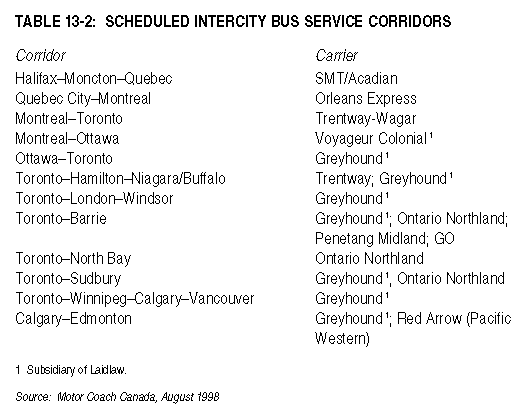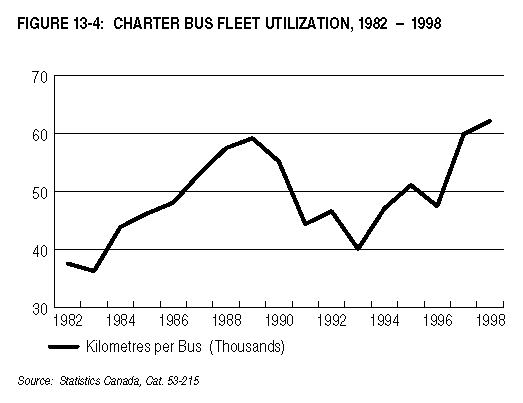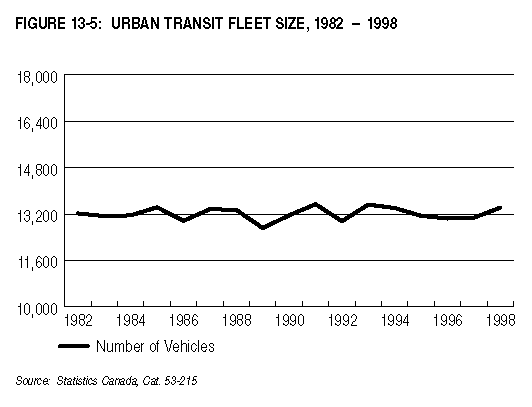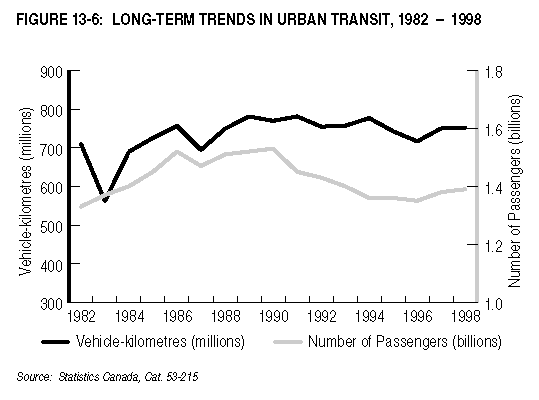13
PASSENGER
TRANSPORTATION
Bus Transportation
Scheduled Intercity Bus Services
In 1998, approximately 13.9 million passengers travelled approximately
134 million kilometres on motor coaches, school buses and other
vehicles used in scheduled intercity bus service operations, according
to Statistics Canada. Scheduled intercity operators carried 44
per cent of those passengers i.e. 6.1 million passengers travelling
46 million kilometres. They achieved this level of activity with
100 main terminals and an additional 1,600 agencies (local businesses
that sell bus tickets).
Figure 13-1 depicts the total number of passengers using scheduled
intercity services provided by all industry segments (intercity
carriers, charter carriers, and school bus operators) from
1980 to 1998. Ridership was in fairly steady decline from the
late 1970s until it hit a low of 10.8 million in 1993. In
recent years, the number of riders has stabilized at between 13.5
and 14 million annually.

Besides offering intercity passenger service, scheduled intercity
operators realize a significant portion of their revenues from
charter bus services, school bus and other passenger bus service,
and bus parcel express service. These services account for an
additional 1.6 million passengers and over 17 million bus-kilometres.
In 1998, according to Statistics Canada, there were 31 operators
with revenues exceeding $200,000 that reported total annual
operating revenues of $133.1 million and operating expenses of
$123.7 million. Approximately 62 per cent of the operating
revenues of these operators came from scheduled intercity services,
with charter and tour services contributing around 11 per cent,
other passenger services nine per cent, and parcel express eight
per cent.
Table 13-2 identifies the main corridors in which scheduled
intercity bus service is offered in Canada and names the operators
providing the service. Laidlaw is the dominant carrier in the
majority of intercity corridors in Ontario and western Canada.

Charter Bus Services
Charter bus activities are closely but not solely tied to tourism,
an activity that has been growing in importance in all regions
of the country.
Figure 13-2, based on Statistics Canada data, shows how revenues
generated from scheduled intercity service and from charter service
have changed since 1990. The data shows that between 1990 and
1994 charter revenues increased gradually and then afterward increased
significantly. Scheduled intercity revenues gradually declined
between 1990 and 1995, and then changed little between 1995 and
1998.

Statistics Canada data also shows that the increase in charter
bus operation revenues was accompanied by growth in the size of
the charter bus fleet. Figure 13-3 shows that the number of vehicles
used in charter service peaked at 3,305 buses in 1996 before declining
to 2,562 in 1998. Data is not broken down by bus type.

Figure 13-4 shows that while the number of vehicles used in
charter bus operations fluctuated during the 1990s, the average
use made of each vehicle steadily increased, from a low of 40,000
kilometres in 1993 to over 62,000 kilometres in 1998.

The expansion in charter service is also indicated by an increase
in annual bus-kilometres. Since 1991, bus-kilometres have increased
by 62 per cent.
Urban Transit Bus Services
The number of vehicles used for urban transit in Canada has
remained fairly stable during the 1990s at between 13,000 and
13,500 a year, as has the utilization rate, in the range of 55,000
to 58,000 kilometres per vehicle per year. Figure 13-5 shows the
number of buses in Canada's urban fleet from 1982 to 1998.

The composition of the fleet has changed over the past five
years, with significantly fewer motor coaches in operation. To
make services more accessible, low-floor buses are being added
to fleets in cities such as Vancouver, Calgary, Thunder Bay, Kitchener
and Montreal. The number of these buses in operation has increased
significantly over the past two years.
Table 13-3 profiles Canada's urban transit fleet by category
from 1991 to 1998.

The number of passengers using urban transit has remained fairly
constant since 1994, after declining in the early 1990s. In 1998,
1.41 billion passengers used urban transit, equalling the level
attained in 1992. The ridership level in 1998 was 2.3 per cent
higher than in 1997.
With the size of the urban transit fleet remaining fairly stable
during the 1990s, Statistics Canada reports that the total distance
travelled was also relatively stable during this period,
at around 750 million kilometres. Figure 13-6 shows these trends
in urban transit from 1982 to 1998.

Bus Transportation
- Appendix 13-1 Status of Transborder
Scheduled Air Services by Airline Domicile, 1991 - 1998
Appendix 13-2 Status of Transborder Air
Services as of December 31, 1999
Appendix 13-3 International Air Services
as of December 31, 1999 (excluding Canada-US Transborder
Air Services)
|

